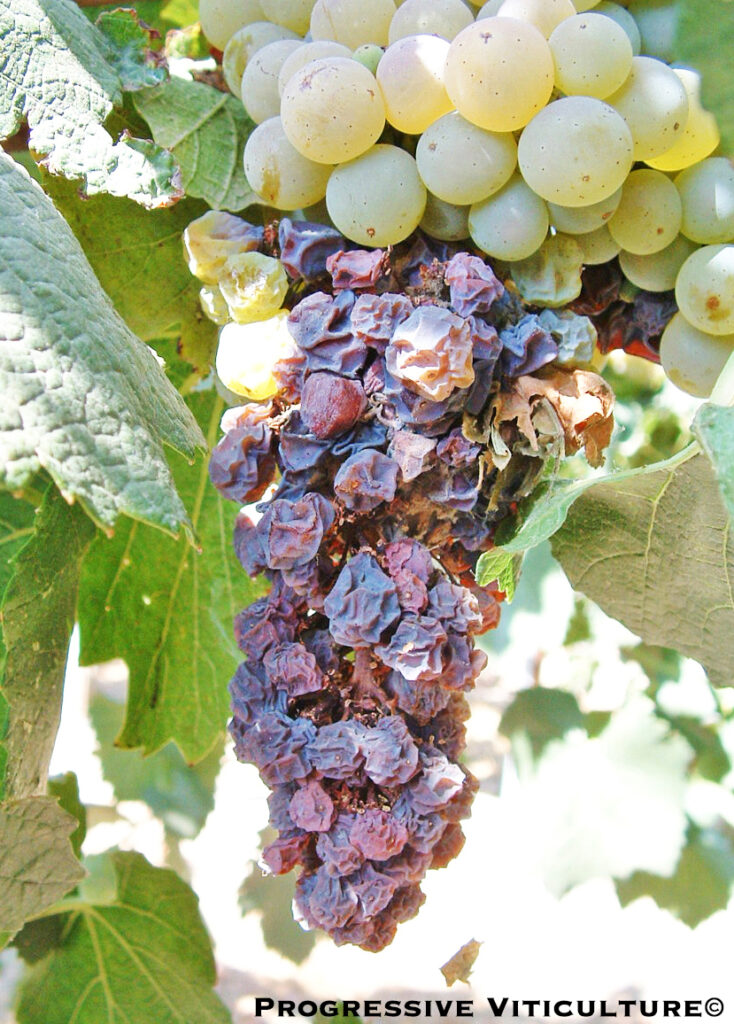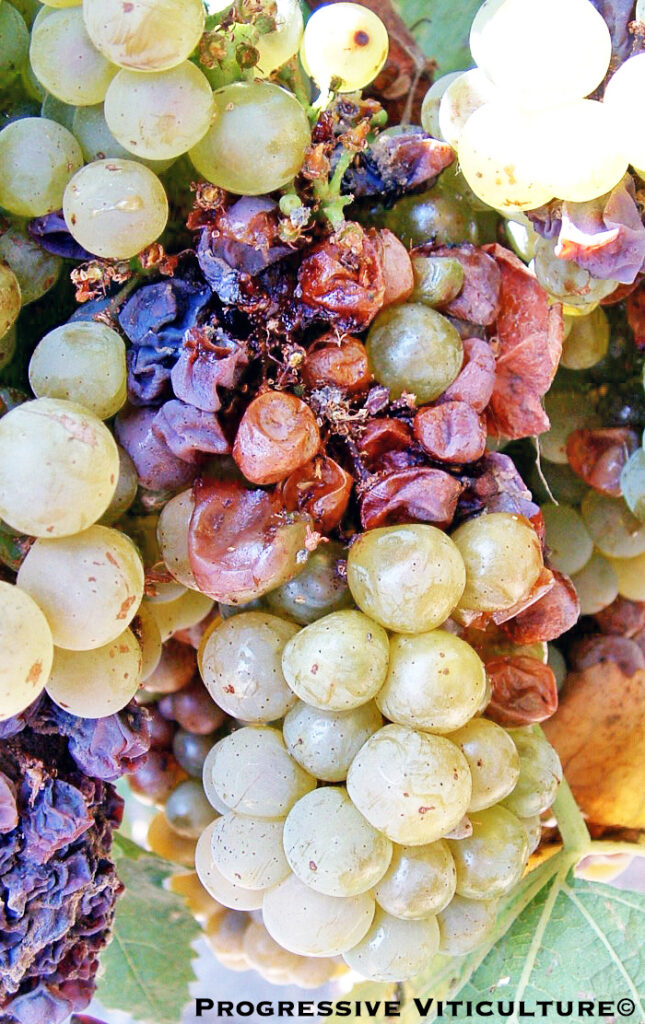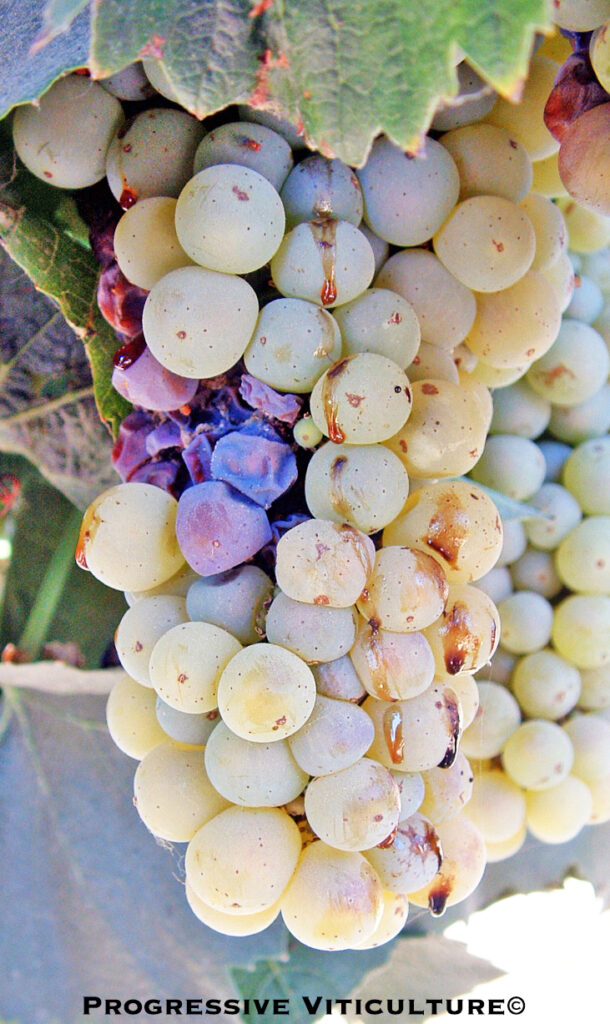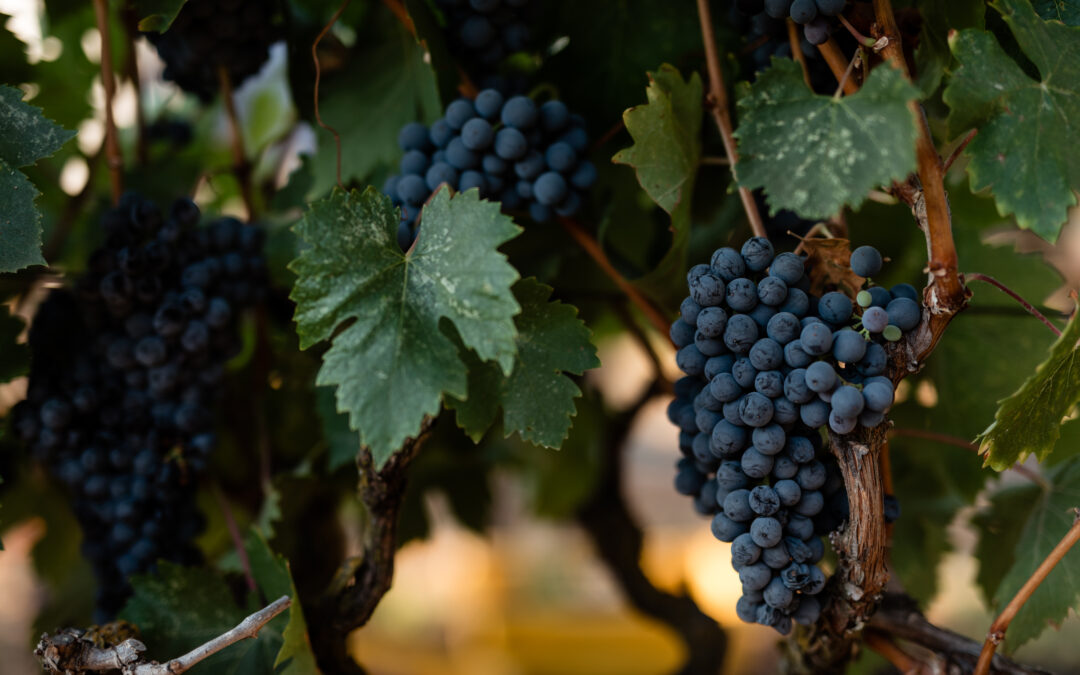MONDAY, JUNE 14, 2021. BY STAN GRANT, VITICULTURIST.
Fortunately for California vineyard managers, they have fewer foliar fungal diseases to contend with than vineyard managers in many other grape-growing regions of the world. Still, fungal disease control demands much of a California grape grower’s time and resources. Obtaining the greatest return on those investments involves an integrated management approach. Bunch rot, a prominent fungal disease in California, is no exception. Bunch rot fungi cause berries to decay during ripening, rendering them unusable for wine production while, at the same time, diminishing crop yield and value.
The disease triangle, a construct developed by plant disease specialists (plant pathologists), serves as a foundation for integrated bunch rot management, as well as the management of other fungal diseases. It involves three general factors that influence the incidence and severity of the disease. These factors are the host plant, the environment, and the pathogen (Figure 1). They are interrelated and for this reason, plant pathologists often think of them as connected by double-headed arrows along the sides of the triangle.
In this article, we will consider the integrated management of bunch rot based upon the relationships presented in the disease triangle. We begin with the pathogen.
The Pathogen – Types of Bunch Rot
In California, bunch rot comes in two basic types. Botrytis bunch rot is the best known of the two and it is the most prevalent type in cooler grape-growing areas (Figure 2). A single fungus, Botrytis cinerea, causes this disease. Given sufficient moisture, Botrytis cinerea can infect berries directly as a primary invader. When provided a point of entry on a damaged berry, it can also act as a secondary invader.

Figure 2. Diseased berry desiccation (Sauvignon blanc) following a mid season botrytis bunch infection. (Photo Source: Progressive Viticulture©)
Summer rot is the other type of bunch rot (Figure 3). This disease thrives in warm temperatures. Summer rot usually involves more than one pathogen and, for this reason, the disease is sometimes called the summer rot complex. Sour rot is yet another name for this disease because it sometimes includes Acetobacter, a bacteria that produces vinegar smells. Summer rot organisms are mainly secondary pathogens, but under the right set of circumstances, a few may act as primary invaders.

Figure 3. The moist center of a Sauvignon blanc cluster infected with the summer rot complex. (Photo Source: Progressive Viticulture©)
The Environment – The Importance of Air Movement
Humid fruit zones foster bunch rot. Air movement, on the other hand, suppresses it. Stated more precisely, increased fruit zone evapotranspiration (ET), which accompanies air movement, limits bunch rot fungi. To promote air movement and evapotranspiration, employ management practices that lessen canopy density, like 1-bud spur pruning, prebloom shoot thinning, and post bloom leaf removal. The enhanced fruit zone exposure these practices effect may also encourage greater development of the protective, waxy cuticle on the exterior of berries, thereby increasing their resistance to rot. It is a happy coincidence that these same canopy management operations normally improve wine grape quality.
Among the benefits of drip irrigation compared to overhead sprinkler and surface irrigation is the potential for less fruit zone humidity. Even so, some drip-irrigated vineyards are more prone to bunch rot than others (Figure 4). Fruit zone humidity increases where drip irrigations are long or very frequent, especially for fruit zones below draping foliage located close to the drip hose. Altering irrigation schedules, using shorter or less frequent water applications, is the simplest remedy for such cases. In other instances, lowering the drip hose to the ground or burying it below ground are effective fixes. Repositioning the foliage more upright or repositioning the fruit zone higher above the ground are normally the most costly solutions for decreasing fruit zone humidity.

Figure 4. Even vineyards with open canopies can suffer bunch rot if the environment is otherwise favorable. (Photo Source: Progressive Viticulture©)
Some insects in the vineyard environment may also influence bunch rot. Certain caterpillars (Lepidoptera larvae) inhabit and feed on grape clusters, creating damage that promotes bunch rot. Orange tortrix is such a pest in coastal areas, while omnivorous leafroller (OLR) similarly functions in much of the California interior. While vinegar fly larvae can feed on damaged berries, their greater impact is as adults transporting bunch rot pathogens from infected to uninfected clusters, including Acetobacter mentioned above.
The Host – Susceptibilities
Not all varieties are created equal with regard to bunch rot. Some appear nearly immune while others are highly susceptible. The basis for these differences lay within clusters.
Varieties with dense, tightly packed clusters are especially prone to bunch rot. Such varieties include Zinfandel, Petite Sirah, Chenin blanc, and Sauvignon blanc. The comparative early and extensive contact between growing berries on tight clusters inhibits the development of the protective cuticle layer on the exterior of berries, increasing their vulnerability to infection.
Later in the season, the pressure of neighboring berries within tight clusters sometimes leads to berries partially disconnecting from their stems (pedicels), exposing interior tissues, causing juice to leak, and encouraging bunch rot (Figure 5). Mechanical damage from worm activity, powdery mildew infections, and other sources compounds the bunch rot susceptibility of tight-clustered varieties.

Figure 5. Berry leakage provides a substrate for bunch rot pathogens. (Photo Source: Progressive Viticulture©)
The environments within-cluster interiors, like fruit zones on a smaller scale, benefit from the cooling and drying effects of air movement, which is limited within dense clusters. Such air movement is especially important after a ripening period of rain. Accordingly, tight-clustered varieties often require environmental modification measures beyond canopy manipulations to minimize bunch rot.
These measures begin when planting a new vineyard. First, select a clone known to have relatively loose clusters, such as the Primitivo clone of Zinfandel (Primitivo-03) or Chenin blanc-04. Some rootstocks are also known to promote loose clusters, including St. George and Dog Ridge. And as mentioned above, locate fruit zones high and away from drip lines, and provide foliage support to position shoots above fruit zones.
In established vineyards, delay crop thinning until near or during veraison and use deficit irrigation schedules to limit berry size. Consider a well-timed prebloom gibberellin application at an appropriate concentration to enhance cluster elongation and allow more space between berries. After initiating irrigations, apply them no more frequently or longer than necessary to avoid severe grapevine water stress. Control powdery mildew, limit worms, and avoid late-season activities that jostle vines to minimize mechanical damage to berries.
After bloom, dead flower parts adhering to clusters support microbes, some of which are involved in bunch rot. Consequently, when dead flower parts are present in abundance, post-bloom fungicide applications to the fruit zone are appropriate to control disease inoculum.
In Summary
Three primary factors influence foliar fungal diseases like bunch rot. They are the host, the environment, and the pathogen. In many circumstances, managing the fruit zone environment is sufficient to control botrytis bunch rot and summer bunch rot. Environmental management actions involve grapevine canopies and vineyard water. For certain vineyards, environmental management alone is not enough, and disease control requires additional measures involving the host. They may include clones, rootstocks, gibberellin, insecticides, and fungicides.
A version of this article was originally published in the Mid Valley Agricultural Services August 2005 newsletter and was updated for this blog post.
Further Reading
Bettiga, L. J. and W. D. Gubler. Bunch rots. In Grape pest management. 3rd Ed. Bettiga, LJ (Ed.). University of California Agricultural and Natural Resources, Oakland, CA. Publication 3343. pp. 93-103. 2013.
Bettiga, L. J., Varela, L. G., and Phillips, P. A. Orange tortrix. In Grape pest management. 3rd Ed. Bettiga, LJ (Ed.). University of California Agricultural and Natural Resources, Oakland, CA. Publication 3343. pp. 372-377. 2013.
Bettiga, L. J., W. D. Gubler, J. J. Marois, and A. M. Bledsoe. Integrated control of Botrytis bunch rot of grape. Calif. Agric. 43, 9-11. 1989.
Bislach, M., G. Minervini, and F. Zerbetto. Possible integrated control of grapevine sour rot. Vitis. 25, 118-128. 1986.
Bledsoe, A. M., W. M. Kliewer, and J. J. Marois. Effects of timing and severity of leaf removal on yield and fruit composition of Sauvignon blanc. Am. J. Enol. Vitic. 39, 49-54. 1988.
Coviello, R. L. and Norton, M. V. Omnivorous leafroller. In Grape pest management. 3rd Ed. Bettiga, LJ (Ed.). University of California Agricultural and Natural Resources, Oakland, CA. Publication 3343. pp. 364-371. 2013.
Duncan, R. Managing bunch rot. Fruit grower. p. 26O-26P. April 1999.
English, J. T., C. S. Thomas, J. J. Marois, and W. D. Gubler. Microclimates of grapevine canopies associated with leaf removal and control of Botrytis bunch rot. Phytopathology. 79, 395-401. 1989.
Grant, S. Cluster elongation to control bunch rot in winegrapes. Wines and Vines. pp. 71-74. May 2013.
Gubler, W. D., J. J. Marois, A. M. Bledsoe, and L. J. Bettiga. Control of Botrytis bunch rot of grape with canopy management. Plant Dis. 71, 599-601. 1987.
Hall, M.E., Loeb, G. M., Cadle-Davidson, L., Evans, K. J., and Wilcox, W. F. Grape Sour Rot: A Four-Way Interaction Involving the Host, Yeast, Acetic Acid Bacteria, and Insects. Phytopathology. 108, 1429-1442. 2018.
Hall, M. E., Loeb, G. M., and Wilcox, W. F. Control of Sour Rot Using Chemical and Canopy Management Techniques. American Journal of Enology and Viticulture. 69, 342-350. 2018.
Hed, B., Ngugu, H. K., and Travis, J. T. Use of gibberellic acid for management of bunch rot on Chardonnay and Vignoles grape. Plant Disease. 95, 269-278. 2011.
Hewitt, W. B. Rots and bunch rots of grapes. Univ. Calif. Div. Agric. Sci. Bull 868. 1974.
Marois, J. J., J. K. Nelson, J. C. Morrison, L. S. Lile, and A. M. Bledsoe. The influence of berry contact within grape clusters on the development of Botrytis cinerea and epicuticular wax. Am. J. Enol. Vitic. 37, 293-296. 1986.
McFadden, W. and Gubler, WD. Sour rot. In Compendium of Grape Diseases. 2nd ed. Wilcox, WF; Gubler, WD; Uyemoto, JK (ed.). APS Press, St. Paul, MN. pp. 87-90. 2015.
Molitor, D., Hoffman, L., and Beyer, M. Flower debris removal delays grape bunch rot epidemic. Am. J. Enol. Vitic. 66, 548-553. 2015.
Pearson, R. C. and D. G. Riegel. Control of Botrytis bunch rot of ripening grapes; timing applications of the dicarboximide fungicides. Am. J. Enol. Vitic. 34, 167-172. 1983.
Percival, D. C., J. A. Sullivan, and K. H. Fisher. Effect of cluster exposure, berry contact, and cultivar on cuticular membrane formation and occurrence of bunch rot (Botrytis cinerea Pers.: Fr.) with 3 Vitis vinifera L. cultivars. Vitis. 32, 87-97. 1993.
Stapleton, J. J. and R. S. Grant. Leaf removal for nonchemical control of summer bunch rot complex of wine grapes in the San Joaquin Valley. Plant Dis. 76, 205-208. 1992.
Thomas, C. S., J. J. Marois, and J. T. English. The effects of wind speed, temperature, and relative humidity on the development of aerial mycelium and conidia of Botrytis cinerea on grape. Phytopathology. 78, 260-265. 1988.
Vail, M. E., and J. J. Marois. Grape clusters architecture and the susceptibility of berries to Botrytis cinerea. Phytopathology. 81, 188-191. 1991.
Vail, M. E., Wolpert, J. A., Gubler, W. D, and Rademacher, M. R. Effect of cluster tightness on botrytis bunch rot in six clones of Chardonnay. Plant Disease. 82, 107-109. 1998.
Willcox, W. F., Mahaffee, W., and Gubler, W. D. Botrytis bunch rot and blight. In Compendium of Grape Diseases. 2nd ed. Wilcox, WF; Gubler, WD; Uyemoto, JK (ed.). APS Press, St. Paul, MN. pp. 39-45. 2015.
Have something interesting to say? Consider writing a guest blog article!
To subscribe to the Coffee Shop Blog, send an email to stephanie@lodiwine.com with the subject “blog subscribe.”
To join the Lodi Growers email list, send an email to stephanie@lodiwine.com with the subject “grower email subscribe.”
To receive Lodi Grower news and event promotions by mail, send your contact information to stephanie@lodiwine.com or call 209.367.4727.
For more information on the wines of Lodi, visit the Lodi Winegrape Commission’s consumer website, lodiwine.com.
For more information on the LODI RULES Sustainable Winegrowing Program, visit lodigrowers.com/standards or lodirules.org.



